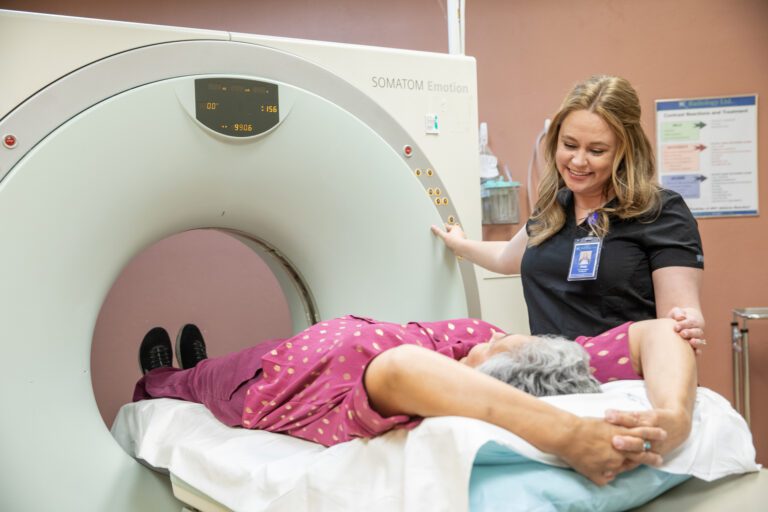Lung cancer is responsible for 1 of every 3 cancer deaths and is the most common cause of cancer death in most populations. LDCT screening can detect many small lung cancers before they are visible on a regular chest X-ray, increasing treatment options and survival rates. A major study called the National Lung Screening Trail (NLST) recently showed a clear benefit for Low-Dose Chest CT (LDCT) Lung Cancer Screening among heavy smokers who meet strict criteria. LDCT screening of this high risk group of asymptomatic people resulted in a 20% reduction in death from lung cancer compared to people in a similar group who were screened with annual chest X-rays only.
You will be asked not to eat for 2 hours prior to the procedure.
1. After you arrive for your appointment, you will be escorted to a procedure room, where you will be asked to change into a patient gown. You should remove all jewelry and other removable items such as glasses, dentures, and hearing aids. Women will be asked to remove bras containing metal underwire. Women should always inform their technologist if there is any possibility of pregnancy.
2. During the exam you will lie on a table that moves into the doughnut-shaped scanner. Your technologist will watch you through an observation window and will be able to communicate with you at all times. CT scans are non-invasive and painless, though you will hear humming, buzzing, or clicking sounds as the CT machine moves to position you. You will be asked to place your arms above your head and will be asked to hold your breath briefly while the images are being taken. It is very important to follow all instructions and remain still during scanning in order to obtain clear images. The entire procedure normally takes about 5-10 minutes, and you will be able to resume your normal activities after the exam.
Although the benefits far outweigh the risks, there can be non-cancerous LDCT scan findings, called false positive results, that can lead to additional cost, radiation exposure, and anxiety. LDCT does not require intravenous contrast injections.
By finding a lung cancer with a screening CT scan when the cancer is small, more effective and potentially curable treatment options become available. In a high number of cases (40%), an abnormality on the screening LDCT study will require follow-up imaging tests, often additional CT scans, to ensure that there is no evidence of interval growth of the abnormality, thus confirming a benign (non-cancerous) finding. Rarely, a lung biopsy might be required to exclude lung cancer.
LDCT screening uses a low radiation dose CT technique. The radiation dose received is equivalent to approximately half of the naturally occurring background radiation a person living at sea level receives in one year.
1. As of February 2015, Medicare will cover LDCT Lung Cancer Screening for beneficiaries who meet the eligibility criteria. Under the federal Patient Protection and Affordable Care Act (PPACA), private insurance companies are now also required to cover this test without a co-pay for patients who also meet the eligibility criteria. If the CT scan detects an abnormality that requires further imaging tests or interventions, these additional procedures are often covered by most insurance plans.
2. Once an individual decides to participate in our CT Lung Cancer Screening Program, their screening appointments will be coordinated by our staff to ensure appropriate follow-up and patient convenience.
1. After your study, the images will be evaluated by one of our board-certified radiologists with expertise in CT lung imaging. A final report will be sent to your doctor or healthcare provider, who can then discuss the results with you in detail.
2. Reports are also available on the MyRAD Patient Portal


